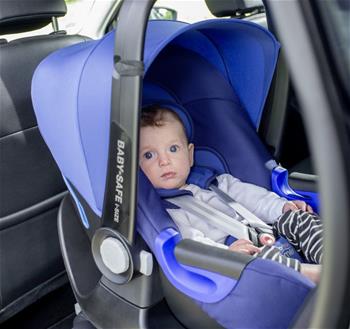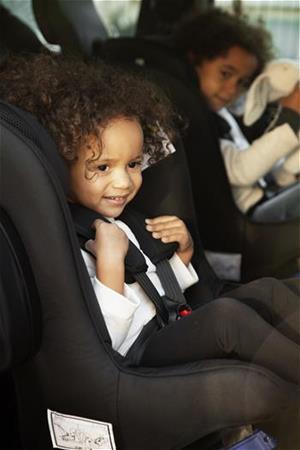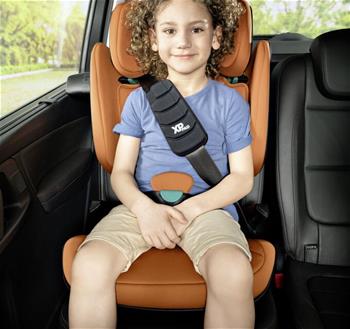Keeping your children safe on every journey
Natalie from Car Seat Ninja, a mum of four who’s on a mission to provide comprehensive car seat advice and a retail service, is offering her years of experience and a wealth of knowledge to help every parent and guardian to keep their child safe on every journey.
By Law, all children must use a suitable restraint in the car until the age of 12 or 135cm tall, whichever comes first. All car seats sold in the UK must undergo a certain level of testing to be legally sold, these are referred to as R44.04 and R129 (i-size). R44 was introduced in the 1980’s and was there to ensure all car seats met the same standards. There were amendments to this regulation over the years, the most recent being in 2005 although very little was changed from the original.

Car seats are subjected to frontal impact at 31mph and rear impact at 18mph. All seats are sold based on the child’s weight alone meaning forward facing is possible for a child weighing a minimum of 9kg (which in some cases can be as young as 6 months old!).
Seats are split into groups, indicating different stages of use with approximate ages which often means that children are moved up to the next stage too early, and rear facing seats have belt guides indicated in blue, whereas you need to follow red for forward facing seats.
The introduction of R129 in 2013 was set out to raise the standards of child seats by improving the protection of the head and neck by adding a side impact test at 15mph and basing the usage of the seat predominantly on the child’s age and height, making it mandatory to rear face until a minimum of 15 months old to ensure the child was further developed.
More sensitive dummies are used to monitor neck loads and other areas of the body in more detail, although these standards are put in place to help keep our children safe, it’s useful to know that many brands will test over and above the minimum standard to ensure their seats will still perform well in more ‘real life’ situations.
Some generic, mass-produced seats will have passed the minimum safety tests but may fail under more harsh conditions so, where possible research the different brands available and utilise independent testing results such as ADAC.
 All drivers are required to use a rear facing harnessed seat from birth. This will often be an infant carrier which are popular due to their compact size which offers snug support and tailored positioning for our smallest babies and will last up to around 15 months old. Infant carriers can often be attached to a pram frame for quick trips out but it’s important to remember that although they provide optimum protection in a vehicle, they’re not intended for extended periods of time and baby should be placed in a lay flat pram or similar wherever possible. Also, following safe practise of not keeping young babies under 6 weeks old in a car seat for more than 30 minutes without a short break and older babies 2 hours.
All drivers are required to use a rear facing harnessed seat from birth. This will often be an infant carrier which are popular due to their compact size which offers snug support and tailored positioning for our smallest babies and will last up to around 15 months old. Infant carriers can often be attached to a pram frame for quick trips out but it’s important to remember that although they provide optimum protection in a vehicle, they’re not intended for extended periods of time and baby should be placed in a lay flat pram or similar wherever possible. Also, following safe practise of not keeping young babies under 6 weeks old in a car seat for more than 30 minutes without a short break and older babies 2 hours.
After this stage you would then generally move onto a larger toddler seat. These all have a 5-point harness which can allow them to stay harnessed up to 25kg and at least 4 years old and have features such as adjustable recline and legroom with some offering a rotating function making it convenient when placing your child in their car seat.
After this stage, based on your child’s age, weight, height and maturity, you can move onto a high back booster secured by the vehicle seat belt. These can have different safety features, but their main purpose is to raise the child up so the seat belt fits correctly over the chest and pelvis, while providing head and body protection and are suitable until a max height of 150cm, so should be used for as long as possible.
There are two ways in which car seats can be installed; using the vehicle seat belt or by using Isofix. Isofix was introduced in 1999 in a bid to make installing child seats simpler, with less margin for error. It became a standard feature in most cars after 2006 and now all new cars have it. It works by having two metal bars built onto the car’s chassis, located where the seat and backrest meet. An isofix seat or base, simply clicks onto these and always have an additional point of contact such as a support leg or a top tether point.
Once you know what type of seat you want it’s important to check its’ compatibility with your car while still allowing the usability of other seats in the car and comfort of other passengers. Many brands offer ‘fit lists’ on their websites to know what’s approved, and there are also many retailers who can offer a test fit service to assess the different options in practise. This service is also useful if you need to fit multiple seats in, you don’t always need a large car to do this, but it does depend on certain factors.
To keep your child as safe as possible when travelling in the car, you should use the best option available to you and only changing it when they’re physically outgrown, rather than upgrading based on the minimum requirements of the next stage. Equally, it’s important to know the limits of your current seat to ensure you don’t exceed the weight or height limit. Doing so will make the seat unsafe to use and may affect the crash performance. Additionally, by keeping your child rear facing until a minimum of 4 years old will significantly reduce their risk of serious injury. For optimum protection, there are many seats which will allow rear facing for even longer. These include seats which have been put through the Swedish plus test which places much higher forces on the neck, too much in fact, for any forward-facing seat to pass.
 Another consideration which allows your child to travel safely is what to dress them in. Car seat harnesses are designed to fit snugly to the body and adding a puffy jacket or snowsuit will prevent that from happening as you effectively create a layer of air between the harness and the child. Although the harness may appear tight against the coat, in an accident the padding will compress creating space which a child could slip out of. It can also cause overheating so the safest thing to do is dress baby in indoor clothes with a blanket over the top for warmth.
Another consideration which allows your child to travel safely is what to dress them in. Car seat harnesses are designed to fit snugly to the body and adding a puffy jacket or snowsuit will prevent that from happening as you effectively create a layer of air between the harness and the child. Although the harness may appear tight against the coat, in an accident the padding will compress creating space which a child could slip out of. It can also cause overheating so the safest thing to do is dress baby in indoor clothes with a blanket over the top for warmth.
Always keep the manual for your seat somewhere accessible so you can refer to it when needing to adjust or remove any inserts or change harness heights as your child grows. They also provide valuable safety information such as where to position the handle of your infant carrier and which positions the seat can be used in at different stages.
Your local retailer should be able to assist with any queries as well as online videos, social media forums and live chats etc from experts from the brands themselves to ensure you make your child’s safety in the car your no.1 priority.
Useful tips for all parents and guardians:
- Be aware of the weight and/or height limits of the seat you’re using. Any age indicated on the product description is very much a guide and will vary with each child.
- Consult your child’s growth centile to help guide you when buying a new seat to ensure it will last for as long as you need it to
- Read the manual before using the seat to make sure you have followed the correct installation process.
- Ensure the harness is at the correct height – it should be level or slightly below the child’s shoulders when rear facing and level or slightly above shoulders if forward facing. If this is incorrect, it could make it easier for the child to wriggle out and may secure the child sufficiently.
- Check harness tension. You should not be able to pinch any slack in the harness once it’s tightened fully.
- Avoid padded or bulky layers as these will prevent the harness fitting snugly. Bulky hoods can also cause the head to be pushed forward so it is not fully protected. Slippery rain jackets/puddle suits should also be avoided as the harness may not grip the fabric. All these can contribute to overheating too.
- Avoid having loose objects in the car, including heavy toys, cups and bottles and tablets as they become a projectile in a collision, risking serious injury.
- Don’t be tempted to move the next stage too early, each stage is designed to offer optimum protection for the child’s size and development and should be used until they reach the limits of the seat.
To find out more about Car Seat Ninja and the service Natalie offers, click here: https://carseatninja.com/

